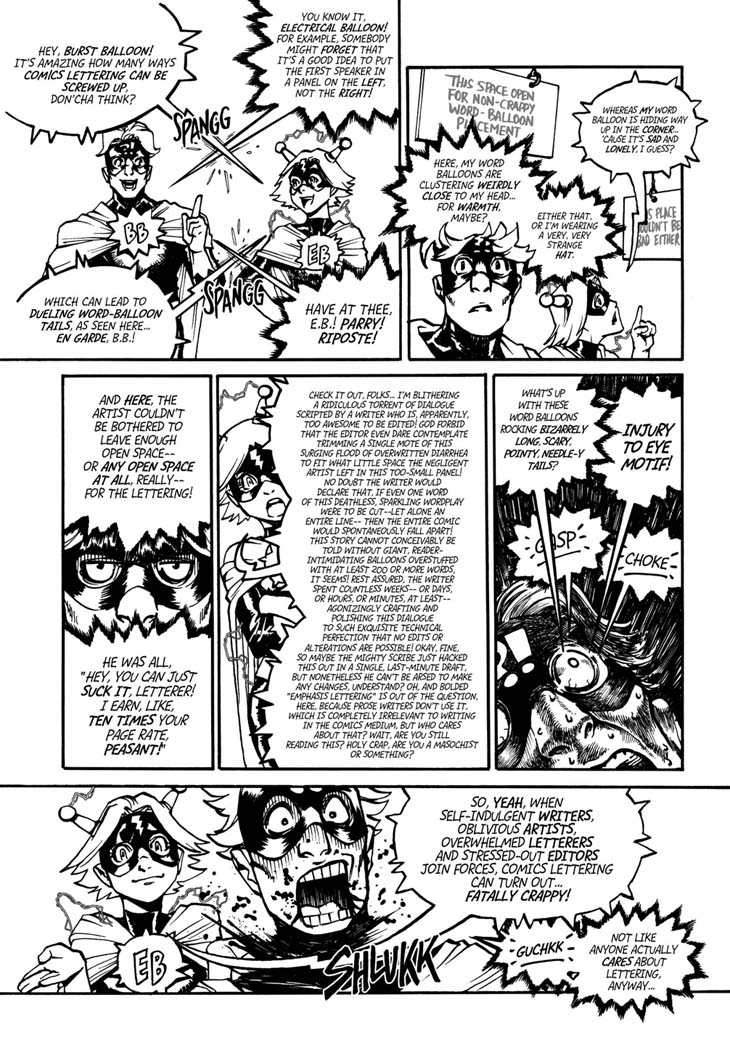Random riff re Panel 1’s “vocabulary-challenged” line: I occasionally run afoul of a certain type of person—and this is almost always a male—who clearly considers himself Quite Frankly Highly Intelligent, but nonetheless becomes threatened and defensive when he thinks you’re pretentiously using “too many big words” for his taste. (God forbid these insecure lads should crack open, say, one of the old Thomas Covenant books, given author Stephen Donaldson’s legendarily abstruse—and often off-base—approach to vocabulary usage.) This becomes a bit of an issue later on in Empowered when the Caged Demonwolf’s dialogue grows baroquely alliterative, but has usually been more of a problem with my earlier, SF-oriented comics work. I’ve rarely employed much more than a modest array of neologisms and technical jargon in my writing—I’m far too ignorant to write genuine “hard SF”, alas—but even that amount sometimes sticks in the craws of prickly fellows who huff and puff about “pretentiousness” and “technobabble.” (Dudes, try reading some g-d prose SF once in a while, and no terminology I’ve ever deployed in comics form would seem particularly obscure or esoteric.) This tendency cracks me up to no end, as it smacks of offended male geeks bleating, “Oh, you think you’re smarter than me, don’t you?” Not much of an improvement, really, over my childhood elementary school’s recess challenges of “Oh, you think you’re tougher than me, don’t you?” A little geekier, certainly, but not any more mature than a bunch of blustering, posturing fifth-grade boys. (Note: I attended a rural grade school in a bygone era, so my experience may have been rather more chest-beating-intensive than the latter-day suburban equivalent.)
Panel 3: Starting to slide perilously close to the dread scourge of “overdialoguing” with this page, alas. Regardless, though, note the importance of leaving all that space open at the upper left portion of the panel for the big ol’ word balloons to go. That is why, Aspiring Comics Artists, it is a very good idea to tackle your comic’s finished lettering after the rough-page or layout stage, but before you begin the final-draft artwork for the panel. If I had drawn the completed pencils before working on the lettering, I might well have screwed myself by leaving inadequate space for the word balloons.
Note also a rare usage of a long balloon tail on the Demonwolf’s second balloon, which I did in order to make it as clear as possible that the ol’ Blazing-Eyed Devilgoat was doing the speaking in this panel. In general, I strongly recommend using the shortest possible tails—or “arrows,” as some call them—on your word balloons, as many of the worst lettering practices in American comics are directly attributable to the long tails used by Western letterers. (Case in point, the “ping-pong dialogue exchange” beloved by many comics writers, which is only possible with elongated, looping tails to connect the barrage of balloons.) As is so often the case, manga artists show us ignorant gaijin a better way to do comics, as most manga word balloons feature highly truncated tails—or, in some daring cases like Kitoh Mohiro (Shadow Star, aka Naru Taru), no balloon tails whatsoever.
While I’m bitching about crappy American lettering practices, here’s an old-ish strip I wrote about this very topic, featuring artwork by the great Takeshi Miyazawa—who worked on an Empowered Guest Artist issue, but that’s another story:

Note the subtle punchline and obscure lettering in-joke hidden throughout the page’s text: You should never use the serifed letter I in a capitalized comics font, except when referring to the first-person singular pronoun.
-Adam Warren

